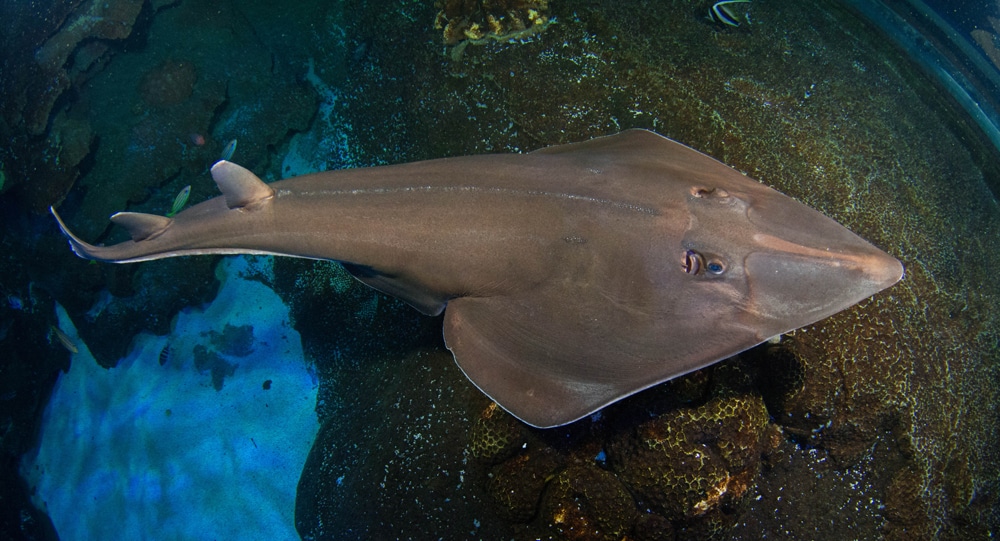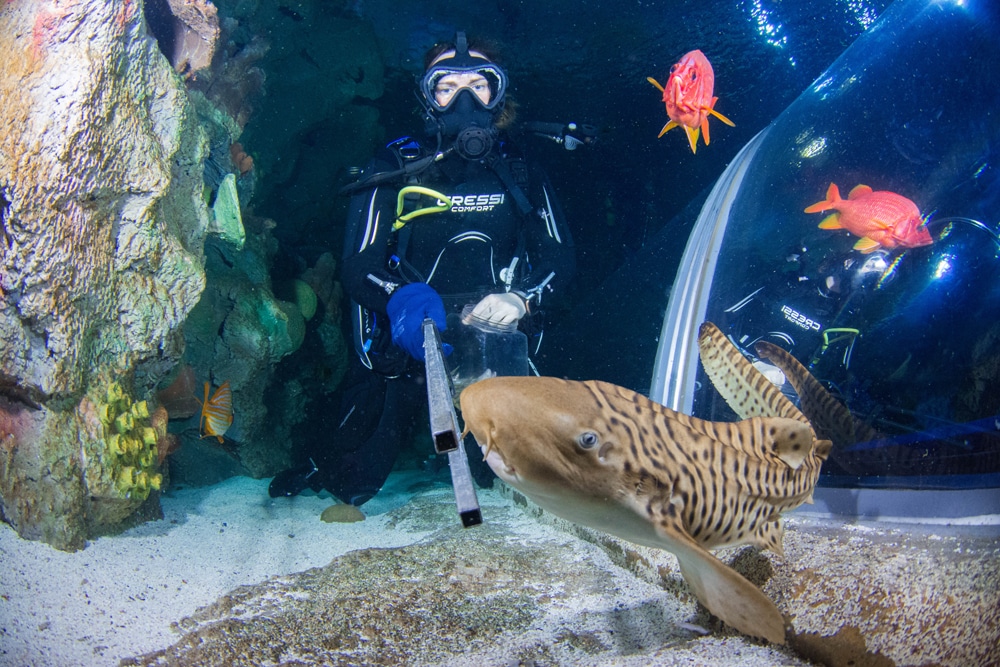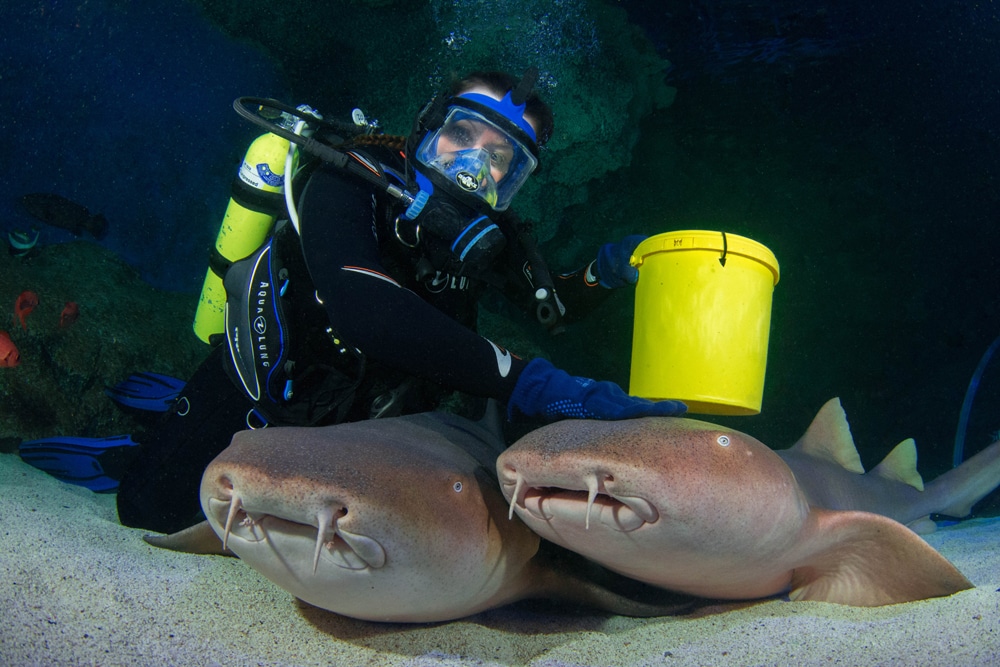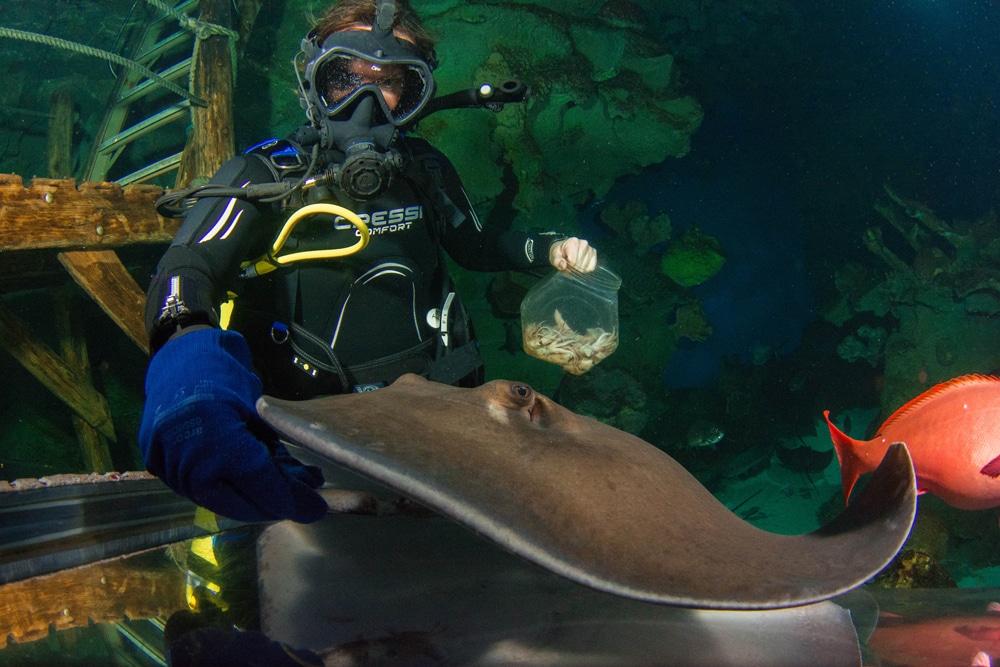Marine Life & Conservation
Feeding Time at the Aquarium

 One of the most important, fun and talked about tasks here at Blue Planet Aquarium is feeding our animals. It’s potentially the task we spend the second most amount of time on after cleaning, this comes as no surprise due to the sheer amount of animals that we have to feed and the ways that they need to be fed. When you have a large diversity of animals to maintain, you also must have a diversity of ways to feed them and so we’ve basically divided our feeding methods into four main categories to help make it easier. These methods are in water hand feeding, in water target feeding, surface target feeding and Scatter Feeds.
One of the most important, fun and talked about tasks here at Blue Planet Aquarium is feeding our animals. It’s potentially the task we spend the second most amount of time on after cleaning, this comes as no surprise due to the sheer amount of animals that we have to feed and the ways that they need to be fed. When you have a large diversity of animals to maintain, you also must have a diversity of ways to feed them and so we’ve basically divided our feeding methods into four main categories to help make it easier. These methods are in water hand feeding, in water target feeding, surface target feeding and Scatter Feeds.
In theory all our animals are target fed as we must go around the tank and target individual animals but the term target feed at Blue Planet basically translates to the fact we use a long pole or Target to feed them, this is done so that the animals in question learn to associate the target or pole with food rather than our hands.
So firstly lets talk about Target feeding with a pole or Target from the surface, this is how the large Sand Tiger Sharks are fed and we feed them with a 9ft pole from the surface, we have a much better field of vision when feeding them this way and it makes it easier to see who’s coming in for food, who may be hungry and to also monitor their behaviour during the breeding season as we have to monitor their changes in behaviour for our records. We feed our Sand Tiger Sharks on a fish-based diet and they get fed fish such as Trevally, Whiting, Mackerel and Saury.
We also feed our Blacktip Reef Sharks from the surface but with a slightly different method and reasons, Blacktip Reef Sharks are renowned for being a little skittish and although ours are more used to divers than those in the wild, they are still scared of the way we look, the noise we create and of course the bubbles so its always easier to feed them from the surface as there’s nothing to scare them off. For our Blacktips we use a Blue circle attached to the end of the pole with the food clip attached to the centre of the circle, we do this as its been shown that although Sharks are colour-blind they tend to respond to Red/Blue colours. This method has proven to be incredibly successful for our Blacktips and they tend to react within seconds of the target entering the water.
We also use shorter poles at around 3ft, underwater for our Goliath Grouper, Wobbegong Sharks and our Zebra Shark Pup Deborah. As mentioned earlier we do this to stop them from associating our hands with food.
The next method is in water Handfeeding and this is how we feed our Stingrays, Nurse Sharks, adult Zebra Sharks, Bamboo Sharks, Guitarfish, Moray Eels and Zebra Bullhead Shark. All food being fed either by a target or by hand, and is all kept in a yellow bucket until its time to be dished out, this makes it easier to control the food, so it doesn’t all just float away. Our Zebra Sharks and Nurse Sharks are fed underwater by hand and this means that we get very close to them which makes these feeds heavily sought after as we get some of our closest encounters, during these feeds we have to handle our animals in some way, whether that be to move them away to give us room in the case of the Zebra Sharks or to keep them calm and under control in the case of the Nurse Sharks.
Our Nurse Sharks tend to get a little over excited and try and get their head in the food bucket. Nurse Sharks have the suction power of seven Dyson hoovers so if they got their head in the food bucket they would inevitably suck all of the food out of the bucket so we have to push their heads down and even give them a little head scratch to keep them calm and controlled. It’s also an amazing chance to see these amazing animals up close and personal and really take in how amazing they are, we also use this opportunity to health-check them and to also show our guests how Sharks really are. Our Nurse and Zebra Sharks are fed on Mackerel, Whiting with Razor Clams.
We also use the method of handfeeding to further train our Stingrays which we feed against the main Aquatheatre or tunnel to show our guests how a stingray feeds, due to the fact that their mouths are underneath it would otherwise be difficult to demonstrate this, so by doing it against the viewing windows it gives the guests an amazing view of stingrays feeding. Using this method also makes it a lot easier to monitor who’s eating and how much each one’s eating.
The last method is possibly the most simple: it’s called a scatter feed and this is where we simply either throw a mixture of food into the water off one of the platforms that run over the main tank or we have a food mixture which we squeeze from a bottle for the many fish that live in the tank at the end of the shows. We can also use this method to throw large chunks of fish at our larger fish such as our Tarpon and Jackfish, and this helps mimic a hunting behaviour so also serves as a type of enrichment. The food mixtures for a scatter feed usually include Chunks of fish like Mackerel and Whiting along with Squid, Sprat, Sand Eel and Krill.
So as you can see there’s a lot of feeding that must be done to keep all of our animals fit and healthy but this is probably the most fun part of the job and whenever we get new members of staff it’s the part of the job that they can’t wait to get started on and it is definitely worth the wait.
For more information about Blue Planet Aquarium please visit their website by clicking here.
Marine Life & Conservation
Paul Watson Released as Denmark Blocks Japan’s Extradition Bid

Renowned anti-whaling activist Paul Watson has been released from custody in Greenland after spending five months in detention. Denmark’s Justice Ministry rejected Japan’s request for his extradition, citing insufficient guarantees that his time already served in custody would be credited against any potential sentence.
The 74-year-old Canadian-American was arrested on July 21 in Nuuk, Greenland’s capital, when his ship docked to refuel. His arrest was based on a 2012 Japanese warrant related to a 2010 encounter in Antarctic waters. Japan alleged Watson obstructed operations and caused damage to a whaling research ship during efforts to disrupt illegal whaling. Watson has consistently denied these claims, maintaining his commitment to marine conservation.
Denmark, which oversees extradition matters for Greenland, concluded that while the legal conditions for extradition were met, the lack of assurances from Japan regarding time-served credit made extradition untenable.
In a video shared by his foundation, Watson expressed gratitude and relief, saying, “After five months, it’s good to be out… and good to know they’re not sending me to Japan.” He added that the most difficult part of his time in custody was being separated from his two young sons.
Watson is a pioneering figure in marine conservation, known for founding the Captain Paul Watson Foundation in 2022 after decades of activism with the Sea Shepherd Conservation Society. His bold efforts to defend marine life have earned him widespread support, including from celebrities and conservationists. His work has also been featured in the acclaimed reality TV series Whale Wars.
Watson’s lawyer, Jonas Christoffersen, praised the decision, stating, “We are happy and relieved that Paul Watson is now free.” He added that Watson is eager to reunite with his family and continue his vital work.
The arrest occurred while Watson’s vessel, the M/Y John Paul DeJoria, was en route to the North Pacific with a team of 26 volunteers to intercept a Japanese whaling ship. His foundation described the arrest as politically motivated and emphasized that Watson’s actions were focused on ending illegal whaling practices.
Japan resumed commercial whaling in 2019 after leaving the International Whaling Commission, asserting that whale meat is a cultural tradition. Conservationists, however, continue to challenge these practices, highlighting their impact on marine ecosystems.
Despite the challenges, Watson remains steadfast in his mission to protect marine life and bring attention to whaling practices. His dedication to ocean conservation has made him a globally respected advocate for the environment.
Marine Life & Conservation
12 Days of Zero-Waste Fish-mas

This holiday period, the Marine Conservation Society, the UK’s leading ocean membership charity, invites you to make some simple changes to eating fish this Christmas to help our seas.
Dr Kenneth Bodles, Head of Fisheries and Aquaculture at the Marine Conservation Society, said, “During the festive season, our consumption increases, but so does waste. Sustainability isn’t just about where food comes from – it’s also about how you use it. By reducing waste and making the most out of your seafood, you’re not only taking steps to be more ocean-friendly, but can also help to cut costs during what is often one of the most expensive times of the year”.
The Marine Conservation Society has compiled twelve tips on how to consume seafood sustainably with zero-waste this Christmas:
Buy whole fish instead of fillets
Instead of fillets, consider buying whole fish such as salmon, hake, or lemon sole. By adopting a “nose to tail” approach with cooking, whole-baked fish not only feeds a crowd, but also helps to minimise waste and maximise sustainability by using up every part of the animal, including bones, skin, and fat.
Make fish stock
Leftover fish bones or shells can be put to good use by boiling them to make a nourishing fish stock or bisque. This can be frozen and preserved for later use and makes for a flavourful base in a soup.
Make your own fish pâté
Avoid waste by turning leftover fish, such as smoked mackerel or salmon, into a delicious pâté by blending with cream cheese and lemon. Perfect when paired with crackers.
The sustainability of salmon and mackerel varies depending on where and how it is caught or farmed. For more information on green-rated options, check the charity’s Good Fish Guide.
Buy frozen
By purchasing seafood that is frozen or vacuum-packed, this helps to reduce waste by extending the shelf life of your food.
Fish pie
If you’re wondering what to do with leftover cooked fish, why not opt for a classic fish pie with mashed potatoes, leeks, and a cheesy sauce? A sure crowd pleaser on Boxing Day.
Use the head
Don’t forget the fish head! The meat is incredibly tender and flavourful. The charity recommends a cod’s head curry or recreating Fallow’s renowned cod’s head in siracha butter.
By stretching your ingredients further, not only is this a more sustainable way to enjoy seafood, but also cost-effective by repurposing leftovers and cooking creatively.
Boxing Day brunch
Mix leftover kippers or smoked salmon with scrambled eggs for a tasty, zero-waste, Boxing Day brunch.
For best choice, make sure you buy kippers, or herring, from the North Sea and the North Irish Sea.
Zero-waste storage
A top tip from the Marine Conservation Society to avoid waste is freezing fish offcuts to save for future use.
Crisp up the skin
Even leftover fish skin can be turned into a quick savoury snack by crisping it up in an air fryer with a little olive oil and salt.
Anchovies two ways
Leftover anchovies can either be blended with butter to make a delicious anchovy butter or tossed into pasta for a hit of umami flavour.
The charity recommends opting for anchovies caught in the Bay of Biscay for best choice.
Fishcakes
For an easy, zero-waste meal, leftover seafood trimmings can be mixed with mash and fried in breadcrumbs to make fishcakes.
Pickled mussels
Try pickling mussels in 1:1 vinegar and water, with a dash of sugar for a sustainable, zero-waste snack that can be enjoyed well beyond the festive season.
Mussels farmed in the UK are a seafood superhero. Grown using low-impact methods and harvested by hand, they get all the food they need from the sea around them. This makes them one of the most sustainable, ocean-friendly, and cost-effective seafood options.
Players of People’s Postcode Lottery have raised £6.6M towards the Marine Conservation Society’s vital work in making seafood more sustainable.
Laura Chow, Head of Charities at People’s Postcode Lottery, said: “Fish is a festive favourite for many, but making sustainable choices when it comes to how we buy and eat seafood makes all the difference for our ocean. Support from players of People’s Postcode Lottery has helped the Marine Conservation Society further its sustainable seafood work, so that we can all enjoy healthier, better protected seas.”
The Marine Conservation Society encourages you to make sustainable seafood choices a year-round habit, not just for Christmas. To check how sustainable the seafood on your plate is, you can visit the charity’s Good Fish Guide. The Guide helps consumers and businesses identify the most sustainable seafood using a simple traffic light system, based on where and how species are caught or farmed. Green is the best choice, amber means improvements are needed, and red indicates fish to avoid buying.
Zero-waste gift idea
Why not embrace a zero-waste Christmas by gifting a membership to support marine conservation? It’s a meaningful, low-waste gift that helps protect our ocean for generations to come. Memberships start from as little as £5 a month – the price of a sandwich and drink from your local coffee shop.
Find the latest sustainable seafood advice for wild-caught and farmed seafood on the Good Fish Guide, downloadable to your phone from www.mcsuk.org/goodfishguide.
-

 News2 months ago
News2 months agoIconic SS United States to become the World’s Largest Artificial Reef
-

 News3 months ago
News3 months agoBook Review – 52 Assignments: Underwater Photography
-

 Gear News3 months ago
Gear News3 months agoDYNAMICNORD – New German diving brand enters the British market
-

 News3 months ago
News3 months agoExploring Cenote El Pit: A Diver’s Dream
-

 Gear News3 months ago
Gear News3 months agoTry BARE drysuits (and maybe even win one!) this Friday with Sea & Sea at North West Dive Fest
-

 Marine Life & Conservation3 months ago
Marine Life & Conservation3 months agoBook Review: Coral Triangle Cameos
-

 Blogs2 months ago
Blogs2 months agoDive the Egyptian Red Sea this Autumn with Regaldive
-

 News3 months ago
News3 months ago2024 Ocean Art Underwater Photo Competition Announced


















